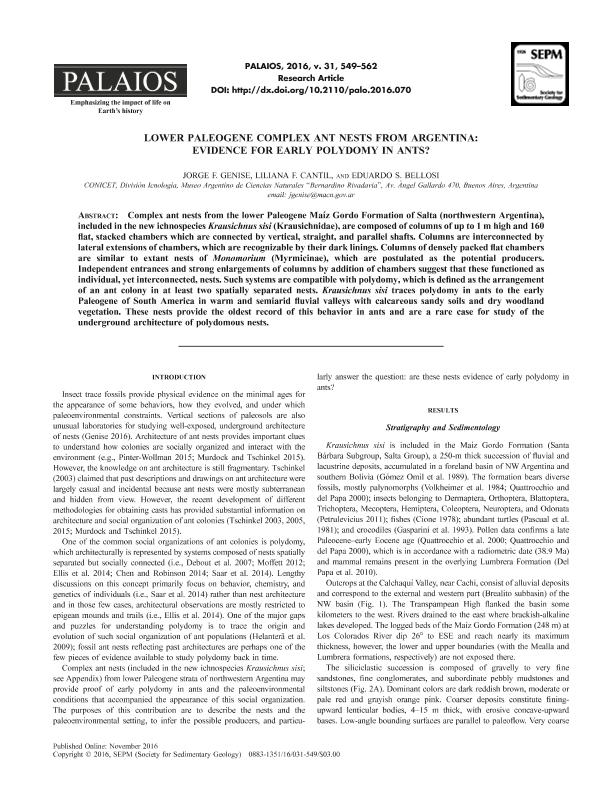Artículo
Lower Paleogene complex ant nests from Argentina: evidence for early polydomy in ants ?
Fecha de publicación:
11/2016
Editorial:
Society for Sedimentary Geology
Revista:
Palaios
ISSN:
0883-1351
Idioma:
Inglés
Tipo de recurso:
Artículo publicado
Clasificación temática:
Resumen
Complex ant nests from the lower Paleogene Ma´ız Gordo Formation of Salta (northwestern Argentina),included in the new ichnospecies Krausichnus sisi (Krausichnidae), are composed of columns of up to 1 m high and 160 flat, stacked chambers which are connected by vertical, straight, and parallel shafts. Columns are interconnected by lateral extensions of chambers, which are recognizable by their dark linings. Columns of densely packed flat chambers are similar to extant nests of Monomorium (Myrmicinae), which are postulated as the potential producers. Independent entrances and strong enlargements of columns by addition of chambers suggest that these functioned as individual, yet interconnected, nests. Such systems are compatible with polydomy, which is defined as the arrangement of an ant colony in at least two spatially separated nests. Krausichnus sisi traces polydomy in ants to the early Paleogene of South America in warm and semiarid fluvial valleys with calcareous sandy soils and dry woodland vegetation. These nests provide the oldest record of this behavior in ants and are a rare case for study of the underground architecture of polydomous nests.
Palabras clave:
Paleosol
,
Salta
,
Paleocene-Eocene
,
Trace Fossil
Archivos asociados
Licencia
Identificadores
Colecciones
Articulos(MACNBR)
Articulos de MUSEO ARG.DE CS.NAT "BERNARDINO RIVADAVIA"
Articulos de MUSEO ARG.DE CS.NAT "BERNARDINO RIVADAVIA"
Citación
Genise, Jorge Fernando; Cantil, Liliana Fernanda; Bellosi, Eduardo Sergio; Lower Paleogene complex ant nests from Argentina: evidence for early polydomy in ants ?; Society for Sedimentary Geology; Palaios; 31; 11; 11-2016; 549-562
Compartir
Altmétricas




